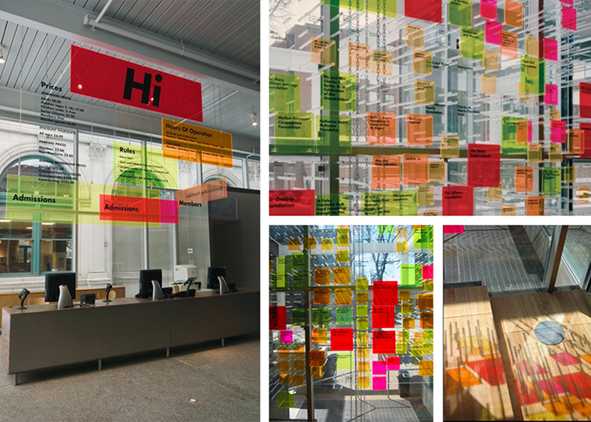Progetto e qualità sensoriale. Materiali e prestazioni per la comunicatività degli spazi museali
DOI:
https://doi.org/10.19229/2464-9309/7172020Parole chiave:
comunicatività ambientale, sensorialità dei materiali, criteri di scelta dei materiali, strutturazione delle informazioni, museiAbstract
Attraverso il progetto è possibile indirizzare i processi percettivi cercando di intervenire sulla capacità dell’ambiente di fornire informazioni intellegibili e significative. Rendere uno spazio comunicativo migliorandone la fruibilità significa prefigurare i processi percettivi e perseguire una migliore qualità dell’interazione uomo-ambiente. Una delle possibili soluzioni è rappresentata dall’uso di materiali sensoriali in grado di fornire prestazioni ‘tangibili’ e nuove funzionalità, grazie alle tecnologie che agiscono in maniera controllata alla micro-scala e a scala nanometrica. A tale proposito vengono presentati i risultati di due ricerche finanziate dall’Ateneo Sapienza Università di Roma, riferiti alla strutturazione di un repertorio di materiali in grado di agire a livello informativo sugli spazi comuni di grandi Poli Museali e alla relativa sperimentazione su musei del circuito romano Musei in Comune, supportata dalla Sovrintendenza Capitolina ai Beni Culturali di Roma.
Downloads
##plugins.generic.articleMetricsGraph.articlePageHeading##
Riferimenti bibliografici
Addington, D. M. and Schodek, D. L. (2005), Smart Materials and Technologies in Architecture – For the Architecture and Design Professions, Architectural Press, Oxford.
Agenzia Roma (2018), Relazione Annuale 2018 – Cultura e tempo libero – Sintesi dei principali indicatori del servizio. [Online] Available at: www.agenzia.roma.it/documenti/schede/relazione_annuale_2018 _cap_6_cultura_e_tempo_libero.pdf [Accessed 26 April 2020].
Ashby, M. F. (2016), Materials Selection in Mechanical Design, 5th Edition, Elsevier Butterworth-Heinemann, Oxford.
Ashby, M. F. and Johnson, K. W. (2009), Materials and Design – The Art and Science of Material selection in product design, 2th Edition, Elsevier Butterworth-Heinemann, Amsterdam.
Bloomer, K. C. and Moor, C. W. (1997), Corpo, memoria, architettura – Introduzione alla progettazione architettonica, Sansoni Editore, Firenze.
Conti, C., Tatano, V. and Villani, T. (2016), “Accessibilità ambientale: verso l’inclusività nella progettazione | Environmental accessibility: towards inclusiveness in design”, in Lucarelli, M. T., Mussinelli, E. and Trombetta, C. (eds), Cluster in progress – La Tecnologia dell’architettura in rete per l’innovazione | The Architectural technology network for innovation, Maggioli, Santarcangelo di Romagna, pp. 28-41.
European Commission (2012), European Audiences – 2020 and beyond. [Online] Available at: doi.org/10.2766/32988 [Accessed 26 April 2020].
Felli, P., Laurìa, A. and Bacchetti, A. (2004), Comunicatività ambientale e pavimentazioni – La segnaletica sul piano di calpestio, ETS Edizioni, Pisa.
Ganucci Cancellieri, U., Manca, S., Laurano, F., Molinario, E., Talamo, A., Recupero, A. and Bonaiuto, M. (2018), “Visitors’ satisfaction and perceived affective qualities towards museums: the impact of recreational areas | Soddisfazione dei visitatori e qualità affettive percepite dei musei: l’impatto delle aree ricreative”, in Rassegna di Psicologia, vol. 35, n. 1, pp. 5-18.
Istat (2019), “L’Italia dei musei”, in Statistiche Today, 23 December 2019. [Online] Available at: www.istat.it/it/files/2019/12/LItalia-dei-musei_2018.pdf [Accessed 26 April 2020].
Karana, E., Hekkert, P. and Kandachar, P. (2008), “Material Considerations in Product Design: A Survey on Crucial Material Aspects Used by Product Designers”, in Materials & Design, vol. 29, issue 6, pp. 1081-1089.
Laurìa, A. (2002), “La comunicatività ambientale”, in Paesaggio Urbano, n. 1, pp. 32-38. [Online] Available at: www.paesaggiourbano.org/2019/09/02/paesaggio-urbano-2002_1/ [Accessed 7 February 2020].
Manzini, E. (1986), La materia dell’invenzione – Materiali e progetto, Arcadia Edizioni, Milano.
Pagani, R., Chiesa, G. and Tulliani, J.-M. (2015), Biomimetica e Architettura – Come la natura domina la tecnologia, FrancoAngeli, Milano.
Pallasmaa, J. (2007), Gli occhi della pelle – L’Architettura e i sensi, Jaca Book, Milano.
Ritter, A. (2007), Smart materials in architecture, interior architecture and design, Birkhauser, Basel.
Scalisi, F. (2010), Nanotecnologie in edilizia – Innovazione tecnologica e nuovi materiali per le costruzioni, Maggioli, Santarcangelo di Romagna.
Schiffman, H. R. (2008), Sensation and Perception, 6th Edition, John Wiley & Sons, New York.
Sposito, A. (ed.) (2009), Nanotech for Architecture – Innovative Technologies and Nanostructured Materials, Luciano Editore, Napoli.
Stanley, C., Ward, L. M. and Enns, J. T. (2004), Sensation and Perception, 6th Edition, Harcourt Brace, Fort Worth.
Thorndyke, P. W. and Hayes-Roth, B. (1982), “Difference in Spatial Knowledge Acquired from Maps and Navigation”, in Cognitive Psychology, vol. 14, issue 4, pp. 560-589.
Villani, T. (2018), “Materiali e soluzioni tecniche per il wayfinding nei musei | Materials and technical solutions for wayfinding in museums”, in Techne | Journal of Technology for Architecture and Environment, vol. 16, pp. 289-298. [Online] Available at: doi.org/10.13128/Techne-23000 [Accessed 12 March 2020].
Zuo, H. (2010), “The selection of materials to match human sensory adaptation and aesthetic expectation in industrial design”, in METU Journal of the Faculty of Architecture, vol. 27, n. 2, pp. 301-319. [Online] Available at: doi.org/10.4305/METU.JFA.2010.2.17 [Accessed 12 March 2020].

##submission.downloads##
Pubblicato
Come citare
Fascicolo
Sezione
Licenza
AGATHÓN è pubblicata sotto la licenza Creative Commons Attribution License 4.0 (CC-BY).
License scheme | Legal code
Questa licenza consente a chiunque di:
Condividere: riprodurre, distribuire, comunicare al pubblico, esporre in pubblico, rappresentare, eseguire e recitare questo materiale con qualsiasi mezzo e formato.
Modificare: remixare, trasformare il materiale e basarti su di esso per le tue opere per qualsiasi fine, anche commerciale.
Alle seguenti condizioni
Attribuzione: si deve riconoscere una menzione di paternità adeguata, fornire un link alla licenza e indicare se sono state effettuate delle modifiche; si può fare ciò in qualsiasi maniera ragionevole possibile, ma non con modalità tali da suggerire che il licenziante avalli l'utilizzatore o l'utilizzo del suo materiale.
Divieto di restrizioni aggiuntive: non si possono applicare termini legali o misure tecnologiche che impongano ad altri soggetti dei vincoli giuridici su quanto la licenza consente di fare.
Note
Non si è tenuti a rispettare i termini della licenza per quelle componenti del materiale che siano in pubblico dominio o nei casi in cui il nuovo utilizzo sia consentito da una eccezione o limitazione prevista dalla legge.
Non sono fornite garanzie. La licenza può non conferire tutte le autorizzazioni necessarie per l'utilizzo che ci si prefigge. Ad esempio, diritti di terzi come i diritti all'immagine, alla riservatezza e i diritti morali potrebbero restringere gli usi del materiale.


















































































